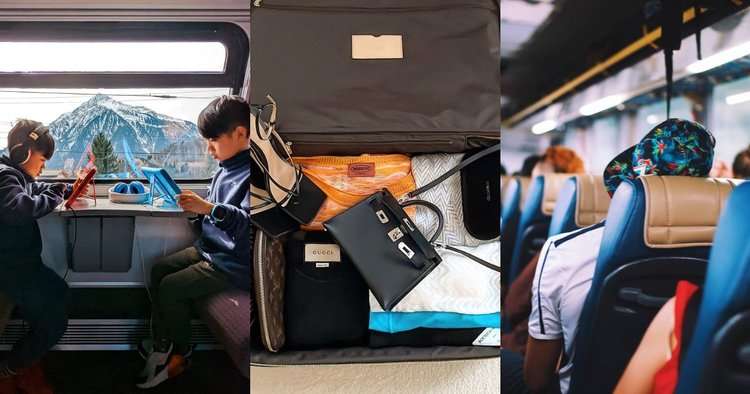Winter travel has its own unique charm—the sight of snow-covered landscapes, festive lights illuminating cozy streets, and the smell of hot drinks coming from cafes. But along with that magic comes one undeniable fact: winter is cold, and staying warm is a non-negotiable if you want to fully enjoy your trip. Whether you’re heading to a winter wonderland in the mountains, wandering through Europe’s famous Christmas markets, or exploring chilly city streets, preparation is key to staying comfortable.
This guide will walk you through every step of staying warm during your winter travels, from what to wear to what to pack, so you can focus on having a great time without worrying about the cold creeping in.

Master the Art of Layering
The foundation of staying warm is all about layering—and doing it right. The concept is simple: wear multiple layers of clothing that trap air between them, which acts as insulation and helps regulate your body temperature. But it’s important to understand what each layer does and why it’s necessary.
- Base Layer: This is the first layer in contact with your skin, and its job is to manage moisture. When you’re outside in the cold, your body still produces sweat, and if that moisture stays trapped against your skin, it will make you feel colder. Look for moisture-wicking materials like merino wool or high-quality synthetics (like polyester or nylon). Merino wool is particularly great because it’s lightweight, breathable, and odor-resistant—perfect for long days on the go. Stay away from cotton because it absorbs moisture and dries slowly, leaving you damp and chilly.
- Mid Layer: The mid layer’s main function is to trap body heat. This is where warmth comes into play. Fleece, down, or synthetic down jackets are great options. Fleece is lightweight, breathable, and dries quickly. If you’re traveling to extremely cold destinations, consider a down or synthetic-filled mid layer, which provides exceptional warmth without adding bulk. Down jackets are often rated by their fill power, with 700+ being excellent for insulation. If you’re worried about rain or snow, synthetic alternatives like PrimaLoft offer similar warmth and retain insulation even when wet.
- Outer Layer: Your outer layer is your protection from the elements. This is the barrier between you and wind, snow, or rain. Look for a waterproof and windproof jacket with good insulation. Gore-Tex or similar technologies provide a great balance between breathability and protection. For versatility, opt for jackets with zip-out liners or down inserts, which can be removed on milder days.
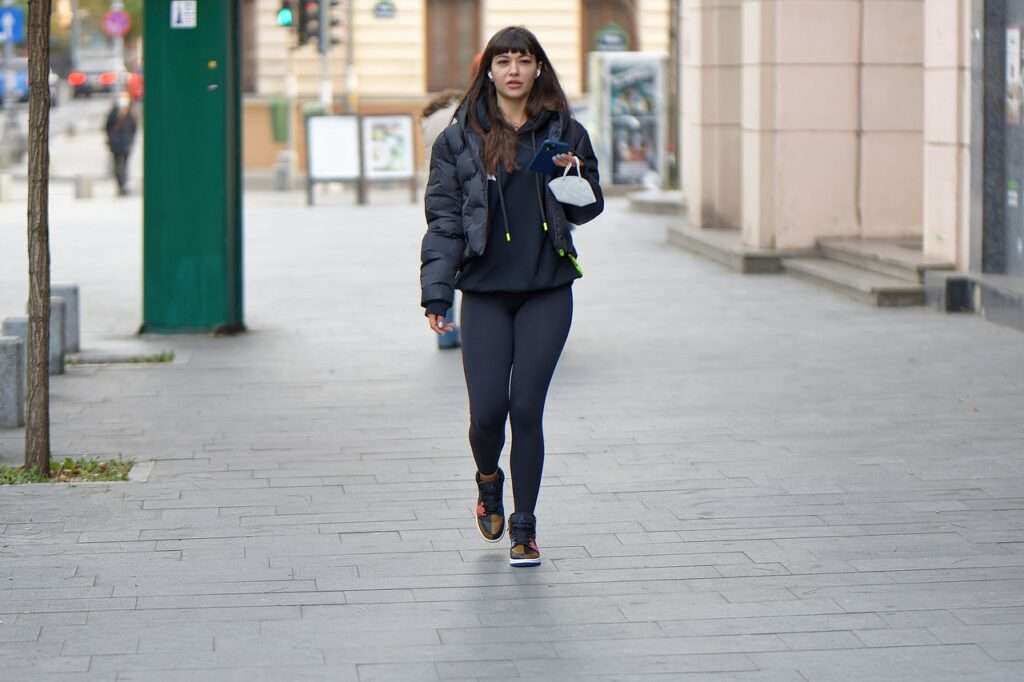
Choosing the Right Layer Combination
When layering, think of how adaptable your outfit is. Can you shed a layer when you pop into a warm cafe? Can you add more if the temperature drops unexpectedly? A well-thought-out layering system should let you adjust to different levels of cold throughout the day.

Choose the Right Winter Coat: Your Biggest Investment
While layers are key, your coat is your barrier against the cold. When it comes to winter travel, investing in a high-quality coat is absolutely worth it.
- Down vs. Synthetic: Down coats are some of the warmest you can find, but they lose insulating properties when wet. If you’re heading somewhere snowy or rainy, consider a water-resistant down or synthetic coat, which will keep you warm even in damp conditions. Synthetic insulation is heavier, but it dries quicker and performs better in wet weather.
- Fit and Length: A good winter coat should be long enough to cover your hips, as keeping your core warm is crucial for overall warmth. Coats that cinch at the waist or have adjustable hoods, cuffs, and hems are great because they allow you to trap warmth or adjust for better mobility.
- Features: Pay attention to coat features like adjustable hoods, lined pockets, storm flaps, and underarm zips for ventilation. A coat with an insulated hood and adjustable cuffs can help seal in warmth on extra-cold days. Look for deep, lined pockets to keep your hands warm or store gloves when not in use.

Don’t Neglect Your Extremities
When the temperatures drop, your body prioritizes keeping your core warm, which is why your hands, feet, and head are the first to feel the cold. Proper gear for your extremities is just as important as a warm coat.
- Gloves or Mittens: The hands are especially vulnerable to the cold, so make sure you invest in high-quality gloves. Insulated, waterproof gloves are essential in snowy conditions. Mittens tend to be warmer than gloves because your fingers share warmth. For convenience, opt for touchscreen-compatible gloves so you can still use your phone without exposing your hands to the cold.
- Hat: Your head loses heat quickly, so wearing a hat is a simple yet effective way to retain warmth. Wool or fleece-lined hats are ideal, as they offer insulation while being breathable. Make sure your hat covers your ears, or opt for earmuffs if you prefer to skip the hat.
- Scarf: A good scarf isn’t just a fashion statement—it’s a functional part of your cold-weather gear. Wrapping a thick wool or fleece scarf around your neck will prevent cold air from entering through the collar of your coat. On particularly windy days, you can pull it up over your face for extra protection.
- Socks and Footwear: Your feet are the foundation of staying warm. Choose merino wool socks—they wick moisture, keep your feet dry, and offer warmth. For footwear, opt for insulated, waterproof boots with a rubber sole to grip icy or snowy surfaces. Boots with fur lining or fleece insulation offer extra warmth and comfort, and make sure they’re roomy enough to allow for thick socks without cutting off circulation.
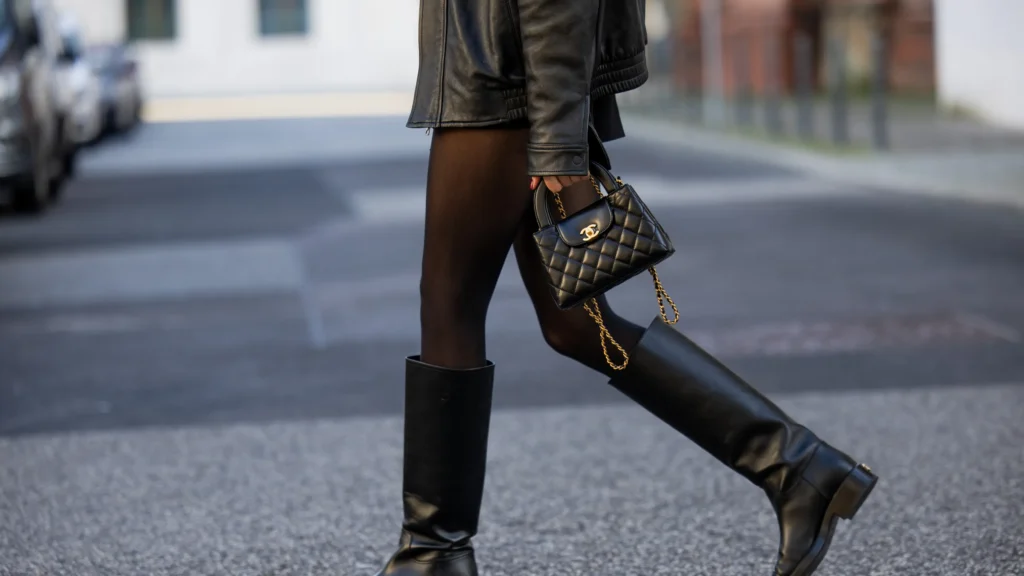
Thermals and Fleece-Lined Tights: The Secret Weapons
If you plan to spend extended time outdoors, consider wearing a pair of thermal leggings or fleece-lined tights under your pants. These are ideal for outdoor activities like hiking, walking tours, or even standing around at holiday markets. They add a lightweight but effective layer of warmth, especially under jeans or non-insulated pants. Thermal tops can also be layered under sweaters or shirts for extra coziness without adding bulk.
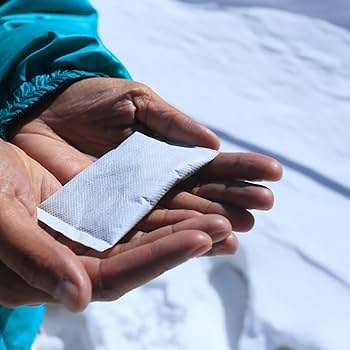
Hand and Foot Warmers: Little Packets of Heat
There’s nothing quite like slipping a hand warmer into your gloves or a foot warmer into your boots when the temperature plummets. These small, single-use packets generate heat for hours and are lightweight enough to carry several in your bag. They’re especially useful if you’ll be out in the cold for long periods, like on a winter hike or attending outdoor events. For eco-friendly travelers, rechargeable warmers are also available and can be reused throughout your trip.
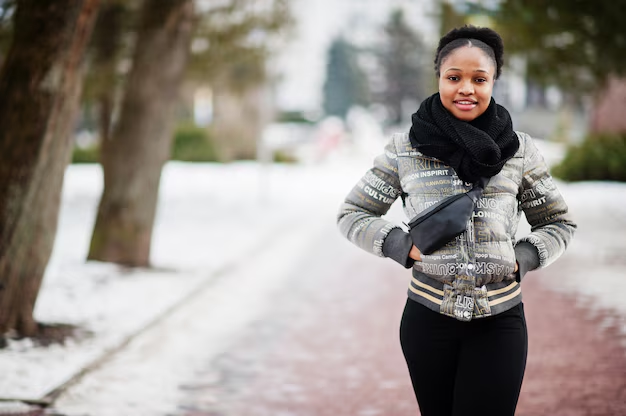
Fabrics Matter: Choose Wisely
Not all fabrics are created equal when it comes to warmth and functionality. The key to staying warm while traveling in winter is selecting the right materials:
- Merino Wool: Lightweight, breathable, and moisture-wicking, merino wool is ideal for base layers, socks, and hats. It also has natural antimicrobial properties, so it won’t smell after multiple wears, making it perfect for travel when you might not have easy access to laundry facilities.
- Fleece: Fleece is synthetic, but it’s soft, warm, and dries quickly, making it an excellent mid-layer. It’s lightweight and traps body heat effectively without feeling bulky.
- Down and Synthetic Insulation: Both materials provide warmth by trapping air. Down is warmer but performs poorly when wet. Synthetic insulation is heavier but continues to insulate when exposed to moisture.
Avoid cotton in cold weather. It absorbs moisture and dries slowly, which can leave you feeling damp and chilly throughout the day.
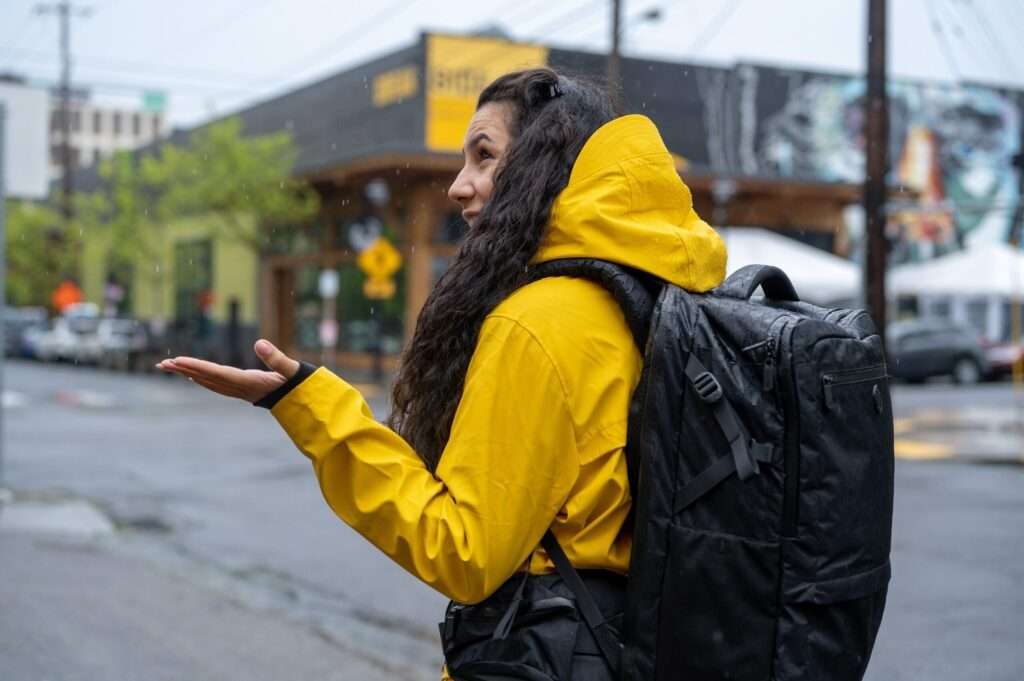
Stay Dry to Stay Warm
One of the most important aspects of staying warm is staying dry. Even the best insulation won’t keep you warm if it’s wet. Waterproof gear—from your jacket to your boots—makes a huge difference, especially in destinations where you might encounter rain, sleet, or snow.
- Outerwear: Invest in waterproof, breathable outer layers, including your jacket, gloves, and boots. Gore-Tex, eVent, and other waterproof fabrics offer protection without sacrificing breathability. Keep an umbrella or packable poncho handy in case of unexpected showers.
- Moisture Management: If you do get wet, change out of damp clothes as soon as possible. Wet clothing pulls heat away from your body much faster than dry clothing, so keeping an extra pair of socks or thermals in your bag can be a lifesaver.

Fuel Up with Hot Food and Drinks
Cold weather burns more calories as your body works to maintain its temperature, so staying well-fed and hydrated is essential. Warm drinks and hearty meals can help you stay warm from the inside out.
- Hot Drinks: Carry a thermos with your favorite hot drink, whether it’s coffee, tea, hot chocolate, or mulled wine. Having something warm to sip on during long outdoor stints will make the cold much more bearable. In many colder regions, street vendors sell hot drinks—try local specialties like gluhwein (mulled wine) in Europe or hot apple cider in the U.S.
- Hearty Meals: Warm, filling meals are essential during winter travel. Soups, stews, and other hearty, warm dishes provide not only comfort but also the energy you need to stay warm. If you’re exploring winter markets or street food scenes, try traditional winter dishes that help locals keep warm, like goulash in Central Europe or pierogi in Poland.

Know When to Take Shelter
No matter how well-prepared you are, sometimes the weather becomes too much. Know when to head inside for a break, whether it’s into a cafe, restaurant, or even public transportation. Prolonged exposure to extreme cold can lead to frostbite or hypothermia, so take regular breaks indoors to warm up.
In cold destinations, make use of heated shelters like warming huts or tourist centers designed for chilly weather conditions. Keep your eye out for cafes with warm fireplaces or heated outdoor seating where you can rest and rejuvenate with a warm drink in hand.
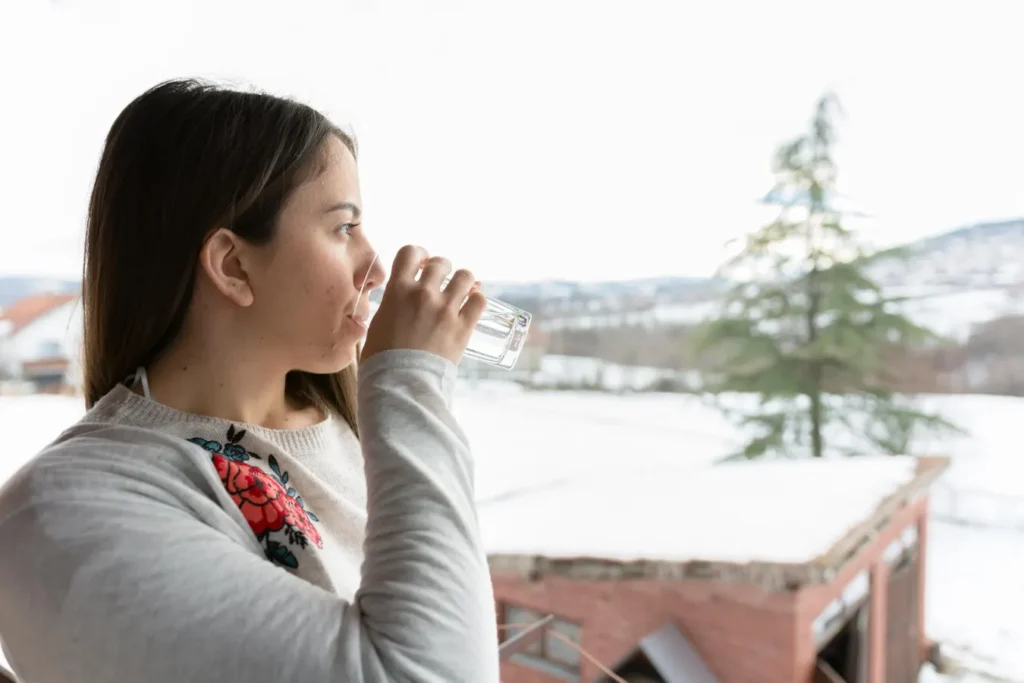
The Importance of Staying Hydrated
Believe it or not, staying hydrated plays a crucial role in keeping your body warm. Your body requires adequate water intake to maintain normal functions, including regulating body temperature. Cold weather can be deceptive—you might not feel as thirsty as you do during warmer months, but you still lose fluids, especially when you’re bundled up and sweating underneath your layers.
- Drink Water: Carry a reusable water bottle and make a conscious effort to drink regularly, even if you’re not thirsty. Insulated bottles can help keep water from freezing if you’re in extreme cold.
- Warm Beverages: Warm beverages not only hydrate you but also help you feel warmer temporarily. Keep a thermos with hot tea, coffee, or hot chocolate with you while exploring. These warm drinks provide immediate comfort, though they don’t necessarily change your core body temperature.

Keep Moving
Movement is essential for generating body heat, especially when you’re outside in the cold for long periods. While it can be tempting to stand still or huddle up to conserve warmth, getting your blood circulating is the best way to stay warm naturally.
- Regular Walks: If you’re sightseeing, plan regular walking breaks to get your heart rate up and circulation going. If you’re standing around, say at a Christmas market or waiting for transportation, do some light movement like walking in place or stretching your arms.
- Take Breaks Indoors: Plan your itinerary to include breaks in warm places. Pop into a museum, cozy cafe, or local store every now and then to warm up and keep your energy levels high.

Heat Packs and Battery-Heated Gear
For especially cold destinations or activities that require being outdoors for extended periods, consider using battery-powered heated gear or disposable heat packs.
- Hand and Toe Warmers: Disposable hand and foot warmers are inexpensive and can be tucked into your gloves or boots for a boost of warmth. They can last up to 10 hours, making them perfect for long hikes or outdoor events.
- Battery-Heated Gear: If you’re traveling somewhere exceptionally cold or spending long hours outdoors, consider battery-powered heated clothing. These come in the form of heated jackets, gloves, socks, and vests. Many models allow you to adjust the heat settings for your desired comfort level and have rechargeable batteries that can last through most of the day.
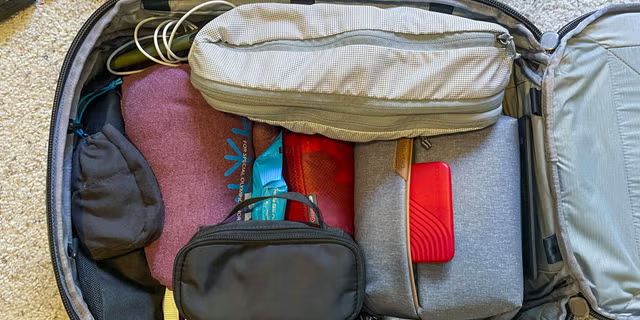
Insulated Travel Gear and Accessories
When planning winter travel, don’t overlook the importance of insulated accessories for carrying your belongings and gadgets, which can help keep your essentials warm and functional.
- Insulated Backpacks: Some backpacks are designed with built-in insulation, which can help protect your electronics and keep things like cameras or phones from getting too cold, as batteries can drain quickly in cold conditions.
- Thermal Camera or Phone Covers: If you’re carrying electronics like a camera or smartphone, consider investing in thermal covers or cases. Cold temperatures can cause devices to malfunction or experience battery drain. Having a thermal case ensures they function properly in harsh weather.
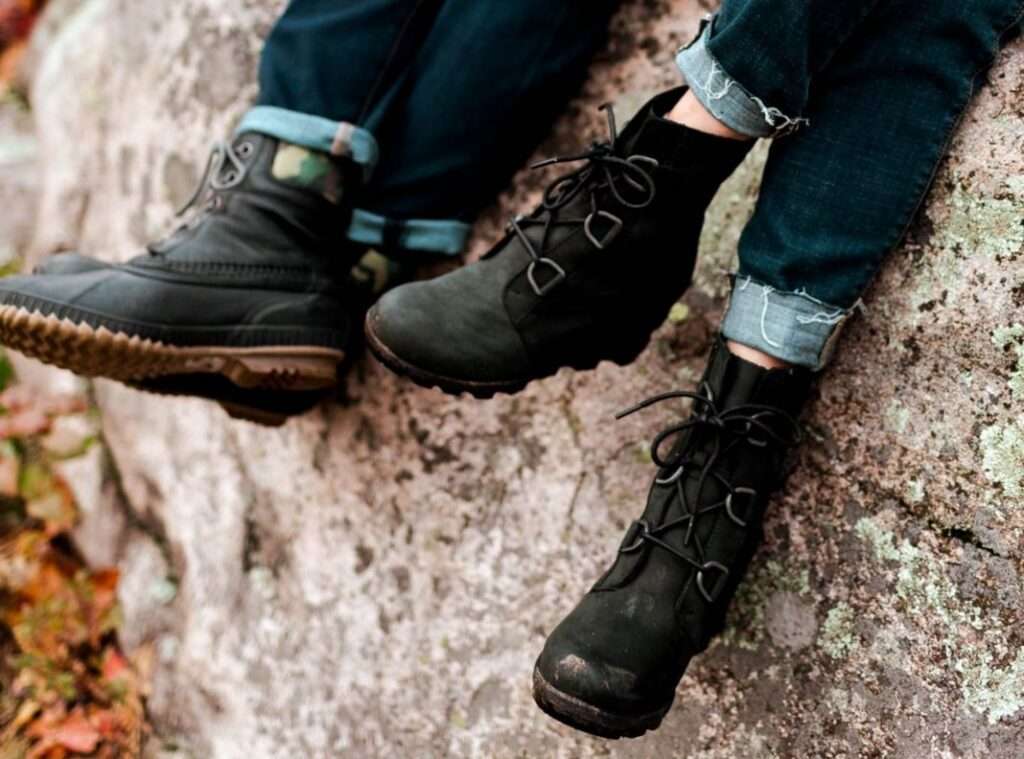
Winter-Ready Footwear: Style Meets Function
Winter travel often means trekking through snow, slush, or icy sidewalks. Regular shoes just won’t cut it. Instead, waterproof, insulated boots are key to keeping your feet warm and dry throughout your trip. But finding the right pair isn’t just about warmth—it’s also about comfort and traction. I really love Sorel.
- Waterproofing: Make sure your boots are waterproof. Cold, wet feet are not only uncomfortable but can also lead to frostbite. Some boots come with built-in waterproofing, but you can also use waterproofing sprays to treat your shoes before the trip.
- Insulation: Choose boots with insulated linings like Thinsulate or shearling. These materials help trap heat while still allowing your feet to breathe. Don’t forget to pair them with thick wool socks for added warmth.
- Traction: Winter conditions can lead to slippery surfaces, so choose boots with good traction. Look for boots with rubber soles designed to grip icy or snowy surfaces, especially if you plan on walking a lot or hiking.

Smart Packing: What to Pack for Winter Travel
Packing smart is critical for winter travel because bulky items can quickly fill up your luggage. Here’s a checklist of winter essentials you should pack:
- Layers: Pack thermal base layers (like merino wool tops and leggings), mid-layers (like fleece jackets), and waterproof outer layers (such as a windproof jacket).
- Accessories: Hats, scarves, gloves (consider a thin liner glove and a thicker insulated glove), and extra socks are a must. Consider bringing a balaclava or neck gaiter if you’re heading to a particularly cold destination.
- Footwear: Waterproof, insulated boots are key. Also, pack extra socks in case you step in puddles or snow.
- Thermos: A small thermos can be useful for carrying hot drinks while sightseeing.
- Hand/Foot Warmers: Easy to pack and a lifesaver when temperatures drop.
- Moisturizers: Cold air is harsh on your skin. Carry a good-quality moisturizer and lip balm to prevent dry, cracked skin and chapped lips.
- Umbrella or Poncho: Rain or sleet is often a factor in winter weather, so a small travel umbrella or foldable poncho can come in handy.

Skin Care in Winter
One of the most overlooked aspects of winter travel is the toll cold, dry air can take on your skin. Winter air is notorious for being dry, which can lead to chapped lips, dry hands, and irritated skin.
- Moisturizers and Lotions: Bring a high-quality moisturizer that contains hydrating ingredients like shea butter, glycerin, or hyaluronic acid. This will keep your skin hydrated and prevent cracking.
- Lip Balm: Cold air can dry out lips quickly. Keep a nourishing lip balm handy and apply it frequently.
- Sunscreen: Don’t skip the sunscreen just because it’s cold. The sun’s rays can still be strong in the winter, especially when reflected off snow. Apply sunscreen to exposed skin, especially if you’re spending the day outside skiing or snowshoeing.

Prepare for Indoor Heating
While outdoor weather can be frigid, indoor heating in some countries may be over-the-top, especially in places like Northern Europe, where central heating is common. Be prepared to adjust your layers when going inside.
- Layering Wisely: Make sure your outfit is easy to adjust. You might find yourself peeling off layers when you step inside a restaurant, train, or store. Avoid super-tight base layers that are hard to take off in public spaces.
- Humidity Packs: If you’re staying in a hotel or rental with intense heating, the air can become very dry, affecting your skin and nasal passages. Humidifiers aren’t always available, so consider bringing humidity packs or a small portable humidifier.
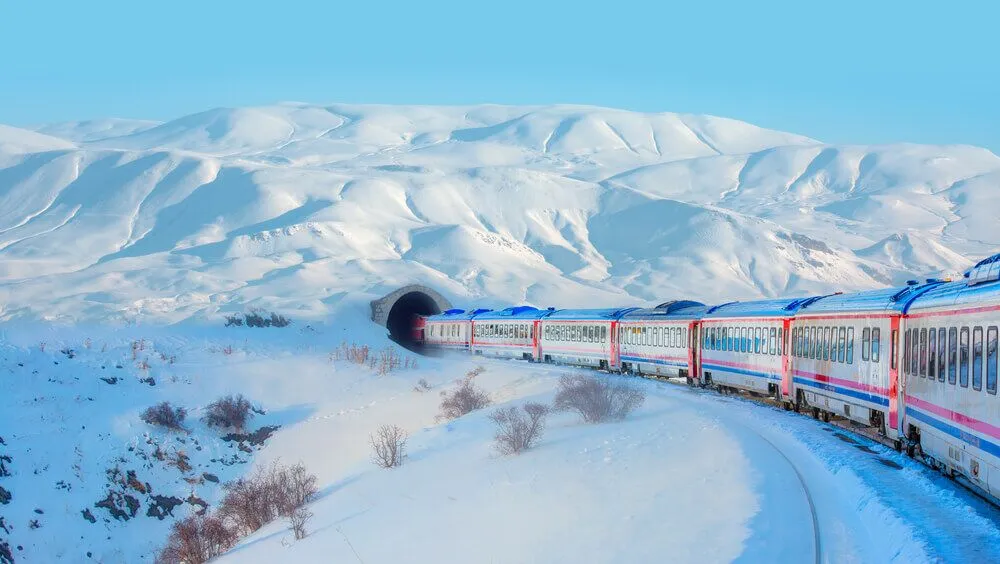
Traveling by Plane or Train in Winter
Traveling by air or train can present its own set of challenges in winter. Planes can get cold, especially during long flights, and train stations are often drafty.
- Travel Blanket: Many airlines don’t provide blankets anymore, or they may run out, so it’s a good idea to bring a travel-sized blanket or large scarf that can double as a wrap.
- Compression Socks: Long flights or train rides can slow circulation, especially in cold weather. Compression socks can help prevent swelling and keep your legs warm.

Stay Warm in Cold Accommodation
Whether you’re staying in a hostel, VRBO, or hotel, indoor heating situations can vary. Some accommodations may not have great heating or could be drafty. Here are a few tips to make sure you’re warm and comfortable at night:
- Portable Heater: If you’re staying somewhere where heating isn’t guaranteed, consider packing a small, portable heater. Just check ahead to ensure it’s allowed and safe in your accommodation.
- Extra Blankets: Sometimes accommodations skimp on blankets, especially in warmer climates where cold snaps are rare. Consider asking for extra blankets or bring a lightweight travel blanket with you.
- Hot Water Bottle: A hot water bottle can be a lifesaver on cold nights. You can easily fill it with warm water from the tap and tuck it into your bed for extra warmth.

Pros and Cons of International Travel During Winter
| Pros | Cons | |
|---|---|---|
| Scenery | Beautiful winter landscapes (snow-capped mountains, frozen lakes, etc.) | Shorter daylight hours, potentially less sunlight |
| Crowds | Fewer tourists at popular destinations, leading to a more relaxed experience | Some attractions and services may be closed or have reduced hours |
| Costs | Lower prices on flights and accommodation compared to peak season | Higher costs for winter-specific gear and clothing |
| Festivities | Enjoy seasonal events and festivals (Christmas markets, winter sports, local traditions) | Weather-related disruptions can affect travel plans and outdoor activities |
| Activities | Opportunities for winter sports (skiing, snowboarding) and cozy indoor activities | Cold weather can limit outdoor activities and make some experiences less enjoyable |
| Comfort | Warm indoor environments, like cafes and hotels, can be very cozy and inviting | Traveling can be uncomfortable due to cold temperatures and potential for snow and ice |
| Health | Cold weather can be invigorating and less likely to carry some illnesses common in warmer months | Increased risk of cold-related health issues (frostbite, hypothermia) and flu or colds |
| Local Experiences | Unique winter experiences and cultural traditions (e.g., winter festivals, holiday markets) | Traveling can be uncomfortable due to cold temperatures and the potential for snow and ice |
| Travel Logistics | Less crowded airports and transportation, making travel smoother | Potential for travel delays due to weather conditions (snow, ice) |
| Accommodation | Cozy, often more affordable lodging options (e.g., winter lodges, cabins) | Some accommodations may be less comfortable or less available due to the season |
| Cuisine | Seasonal food and drinks (hot soups, mulled wine) | Some local eateries may have seasonal closures or limited menus |
| Wildlife | Potential to see unique winter wildlife or migrations | Some attractions may be seasonal or closed during the winter months |

Final Thoughts on Winter Travel
Staying warm while traveling in the winter requires more than just a thick coat—it’s about smart layering, choosing the right fabrics, and being prepared for changing conditions. The key to truly enjoying the cold is preparation. By packing smart, choosing the right gear, and staying mindful of your body’s needs, you can experience the beauty of winter without the discomfort of being cold.
Embrace the chill, but stay warm with these tips—and let your winter travels be filled with warmth, comfort, and unforgettable memories!
Safe Travels!

